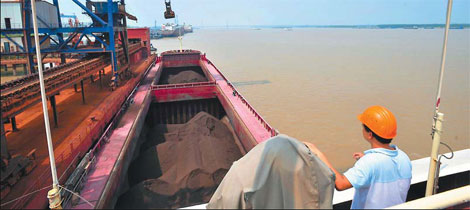Biz News Flash
Steel industry outlook still hazy
By Zhang Qi (China Daily)
Updated: 2010-09-03 10:19
 |
Large Medium Small |
|
 |
|
Imported iron ore from Brazil ready for unloading at Wuhan Iron and Steel Co's port in Hubei province. [Shepherd C Zhou / for China Daily] |
BEIJING - Despite the prospects of lower iron ore prices for the fourth quarter of this year, the overall outlook for domestic steel mills still remains hazy due to weak demand from downstream sectors, industry sources said on Thursday.
Iron ore prices fixed by the big three global miners - Vale, BHP Billiton and Rio Tinto - are expected to fall by 10 percent in the fourth quarter, according to estimates from major steel indexes.
Vale, the world's biggest iron ore producer, said it would cut prices by 10 percent in October due to weak demand from Chinese steel mills for the last five months.
Rio Tinto on Thursday said the contract prices for the steelmaking commodity is likely to fall by 13 percent in the fourth quarter.
Should that materialize, it would be the first time that global miners cut iron ore price after the big miners decided to price the commodity on a quarterly basis compared with annual contracts earlier.
Analysts said the iron ore price decline will have little impact on the fortunes of steelmakers. The 10 percent fall in ore prices will hardly offset the pressure from falling steel prices, they said.
Prices of Australian iron ore fell by $26 per ton in the third quarter, while steel-making costs went up by 274 yuan ($40) per ton during the period. But steel prices declined more than 300 yuan per ton during the same period, said Hu Kai, an analyst from Umetals.com
"Downstream sectors like auto and home appliances are still overstocked on steel and this could weaken demand in the fourth quarter," said Hu.
Domestic steel prices are still under pressure due to weak demand and dwindling exports after the scrapping of export rebates, said Ma Guoqing, general manager of Baosteel.
Chen Ying, the company's chief financial officer, said domestic steel prices in the fourth quarter are likely to decline further.
Steel production in China reached a four-month low in June due to weak demand from real estate companies and the automobile industry.
Steel output fell by 3.9 percent in July to 51.7 million tons compared with June.
Nearly 40 percent of domestic steel mills have been forced to make cutbacks or put their plants on a maintenance mode, due to rising ore costs and falling steel prices, said Luo Bingsheng, vice-chairman of China Iron & Steel Association.
But most of the steelmakers are now planning to ramp up production price in September, said sources.




